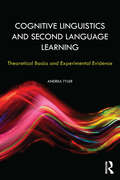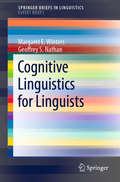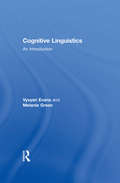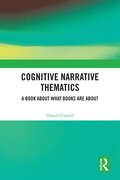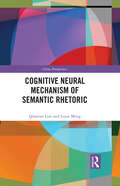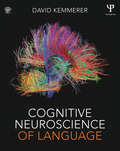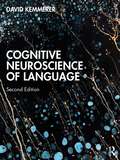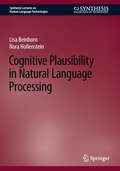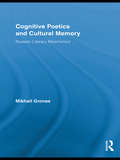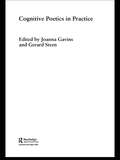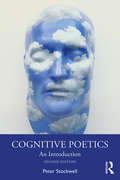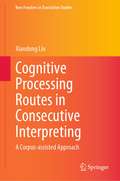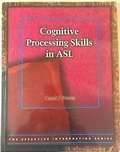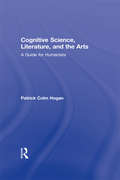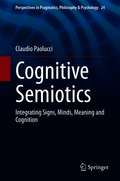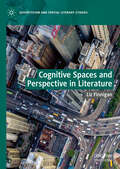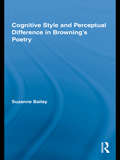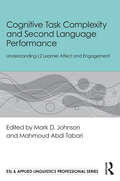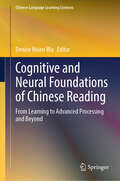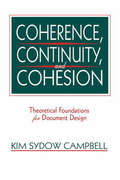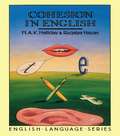- Table View
- List View
Cognitive Linguistics and Second Language Learning: Theoretical Basics and Experimental Evidence (Second Language Acquisition Research Series)
by Andrea TylerThis book illustrates the ways that cognitive linguistics, a relatively new paradigm in language studies, can illuminate and facilitate language research and teaching. The first part of the book introduces the basics of cognitive linguistic theory in a way that is geared toward second language teachers and researchers. The second part of the book provides experimental evidence of the usefulness of applying cognitive linguistics to the teaching of English. Included is a thorough review of the existing literature on cognitive linguistic applications to teaching and cognitive linguistic-based experiments. Three chapters report original experiments which focus on teaching modals, prepositions and syntactic constructions, elements of English that learners tend to find challenging. A chapter on “future directions” reports on an innovative analysis of English conditionals. Pedagogical aids such as diagrams and sample exercises round out this pioneering and innovative text.
Cognitive Linguistics for Linguists (SpringerBriefs in Linguistics)
by Margaret E. Winters Geoffrey S. NathanThis volume offers an introduction to cognitive linguistics, written by authors who were engaged in the field from its beginnings. It starts by reviewing these early studies and provides an overview of the sources and conceptual underpinnings of the theory. This is followed by a description of how cognitive linguistics has been (and continues to be) applied in all subcomponents of language study. From the point of view of the history of Linguistics, it presents the evolution of the theory over time in a range of directions, including its view of the nature of Language itself, as well as how it is acquired. The final chapter provides an overview of relatively new approaches, in particular those which are provoking a significant challenge to the generative account.
Cognitive Linguistics: An Introduction
by Vyvyan Evans Melanie GreenA general introduction to the area of theoretical linguistics known as cognitive linguistics, this textbook provides up-to-date coverage of all areas of the field, including recent developments within cognitive semantics (such as Primary Metaphor Theory, Conceptual Blending Theory, and Principled Polysemy), and cognitive approaches to grammar (such as Radical Construction Grammar and Embodied Construction Grammar). The authors offer clear, critical evaluations of competing formal approaches within theoretical linguistics. For example, cognitive linguistics is compared to Generative Grammar and Relevance Theory. In the selection of material and in the presentations, the authors have aimed for a balanced perspective.Part II, Cognitive Semantics, and Part III, Cognitive Approaches to Grammar, have been created to be read independently. The authors have kept in mind that different instructors and readers will need to use the book in different ways tailored to their own goals. The coverage is suitable for a number of courses.While all topics are presented in terms accessible to both undergraduate and graduate students of linguistics, cognitive linguistics, psycholinguistics, cognitive science, and modern languages, this work is sufficiently comprehensive and detailed to serve as a reference work for scholars who wish to gain a better understanding of cognitive linguistics.
Cognitive Load Theory and Foreign Language Listening Comprehension
by Dayu JiangThis book presents an interdisciplinary approach to understanding the learning and listening skills of a foreign language from the perspectives of cognitive load theory and second language acquisition theories. It explores when and how foreign language listening skills could be curiously improved more effectively by reading than by listening. The results of randomized controlled experiments in the book demonstrate an expertise reversal effect, which calls teachers to adjust instructional approaches to accommodate learners’ expertise level. The book expands the existing language comprehension frameworks by including working memory load as a crucial factor in written or verbal information processing. It also develops cognitive load theory by applying it in a less well-structured subject area—foreign language learning.The book is of interest to postgraduate teachers and learners of a foreign language, instructional designers, educational policy makers, and academic researchers in the fields of learning sciences, curriculum and pedagogy, educational psychology, cognitive load theory, second language acquisition, and foreign language teaching and learning.
Cognitive Narrative Thematics: A Book About What Books Are About
by Daniel CandelCognitive Narratives Thematics proposes a new way in which narrative works organise their thematic material. It rehabilitates the study of what books are about by providing a cognitive narrative thematic model (CNT). Part I presents CNT by combining different approaches to narrative, such as evolutionary theory, semiotics, possible worlds theory, or rhetorical criticism. Part II applies CNT to a variety of well-known narratives in different modalities, such as Robert Browning’s "My Last Duchess", Julia Donaldson’s The Gruffalo, Maurice Sendak’s Where the Wild Things Are, Frank Miller’s 300, or Mike Mignola’s Hellboy. It also considers literary histories and digital humanities. Daniel Candel shows that CNT deserves greater attention and that thematics generates its own forms and adds to the aesthetic pleasure of the text. Candel illustrates that CNT improves the established interpretations of the narrative works it studies. This innovative study reveals how CNT offers readers a deeper understanding, and how readers and critics are often using CNT intuitively without being aware of it. It is an invaluable resource for students and scholars of narrative theory.
Cognitive Neural Mechanism of Semantic Rhetoric (China Perspectives)
by Qiaoyun Liao Lijun MengThis book is a necessary supplement to the theoretical exploration into semantic rhetoric, particularly a breakthrough in the study of the relationship between the source domain and target domain involved in the construction of semantic rhetorical discourse.The study focuses on rhetorical expressions constructed by means of semantic variation or deviation of concepts. Based on the holistic cognitive pragmatic model and the framework of impartment and inheritance of connotation and denotation, this book constructs a new framework, the Annotation-Denotation Relevance-Inheritance Model (ADRIM) to explain the construing of semantic rhetoric. Besides, rooted in the Index Hypothesis Theory and the research paradigm of affordance derivation in language comprehension, three ERP experiments on metaphor, irony, and pun, are conducted to demonstrate the psychological reality that people activate possible feature extraction in the process of understanding semantic rhetoric. With those sample analyses and experiments, the feasibility and operability of ADRIM are proved. The book unfolds a combined approach of speculative research and empirical research, and can provide a new methodological alternative for semantic rhetorical studies in different languages.This title will be an essential read to students and scholars of Linguistics, East Asian Studies, and social workers who are interested in Language Studies in general.
Cognitive Neuroscience of Language
by David KemmererLanguage is one of our most precious and uniquely human capacities, so it is not surprising that research on its neural substrates has been advancing quite rapidly in recent years. Until now, however, there has not been a single introductory textbook that focuses specifically on this topic. Cognitive Neuroscience of Language fills that gap by providing an up-to-date, wide-ranging, and pedagogically practical survey of the most important developments in the field. It guides students through all of the major areas of investigation, beginning with fundamental aspects of brain structure and function, and then proceeding to cover aphasia syndromes, the perception and production of speech, the processing of language in written and signed modalities, the meanings of words, and the formulation and comprehension of complex expressions, including grammatically inflected words, complete sentences, and entire stories. Drawing heavily on prominent theoretical models, the core chapters illustrate how such frameworks are supported, and sometimes challenged, by experiments employing diverse brain mapping techniques. Although much of the content is inherently challenging and intended primarily for graduate or upper-level undergraduate students, it requires no previous knowledge of either neuroscience or linguistics, defining technical terms and explaining important principles from both disciplines along the way.
Cognitive Neuroscience of Language
by David KemmererCognitive Neuroscience of Language provides an up-to-date, wide-ranging, and pedagogically practical survey of the most important developments in this exciting field. It guides students through all of the major areas of investigation, beginning with the fundamental aspects of brain structure and function and then following with key topics such as classic and progressive aphasia syndromes; speech perception and production; the meanings of object nouns, action verbs, and abstract words; the formulation and comprehension of complex expressions, including grammatically inflected words, complete sentences, and entire stories; and several other domains of neurolinguistic research, including reading and writing, sign language, and the bilingual brain. Drawing heavily on prominent theoretical models, the core chapters illustrate how such frameworks are supported, and sometimes challenged, by experiments employing diverse brain mapping techniques. This edition has been thoroughly updated throughout, and now includes a dedicated chapter on the neural substrates of bilingualism. Chapters have been revised to reflect the most salient developments in the field, and the book has undergone a thoughtful restructure to mirror course teaching. While the study of language can be challenging, the text has been written accessibly and requires no previous knowledge of either neuroscience or linguistics and includes definitions of technical terms and explanations of important principles from both disciplines along the way. Accompanied by online resources for students and instructors, it is an essential companion for graduate or upper-level undergraduate students.
Cognitive Neuroscience of Natural Language Use
by Roel M. WillemsWhen we think of everyday language use, the first things that come to mind include colloquial conversations, reading and writing e-mails, sending text messages or reading a book. But can we study the brain basis of language as we use it in our daily lives? As a topic of study, the cognitive neuroscience of language is far removed from these language-in-use examples. However, recent developments in research and technology have made studying the neural underpinnings of naturally occurring language much more feasible. In this book a range of international experts provide a state-of-the-art overview of current approaches to making the cognitive neuroscience of language more 'natural' and closer to language use as it occurs in real life. The chapters explore topics including discourse comprehension, the study of dialogue, literature comprehension and the insights gained from looking at natural speech in neuropsychology.
Cognitive Plausibility in Natural Language Processing (Synthesis Lectures on Human Language Technologies)
by Lisa Beinborn Nora HollensteinThis book explores the cognitive plausibility of computational language models and why it’s an important factor in their development and evaluation. The authors present the idea that more can be learned about cognitive plausibility of computational language models by linking signals of cognitive processing load in humans to interpretability methods that allow for exploration of the hidden mechanisms of neural models. The book identifies limitations when applying the existing methodology for representational analyses to contextualized settings and critiques the current emphasis on form over more grounded approaches to modeling language. The authors discuss how novel techniques for transfer and curriculum learning could lead to cognitively more plausible generalization capabilities in models. The book also highlights the importance of instance-level evaluation and includes thorough discussion of the ethical considerations that may arise throughout the various stages of cognitive plausibility research.
Cognitive Poetics and Cultural Memory: Russian Literary Mnemonics (Routledge Research In Cultural And Media Studies #28)
by Mikhail GronasIn this volume, Gronas addresses the full range of psychological, social, and historical issues that bear on the mnemonic existence of modern literary works, particularly Russian literature. He focuses on the mnemonic processes involved in literary creativity, and the question of how our memories of past reading experiences shape the ways in which we react to literary works. The book also examines the concrete mnemonic qualities of poetry, as well as the social uses to which poetry memorization has historically been put to use. This study will appeal to scholars of cognitive poetics, Russian literature, and cultural studies.
Cognitive Poetics in Practice
by Joanna Gavins Gerard SteenCognitive Poetics is a new way of thinking about literature, involving the application of cognitive linguistics and psychology to literary texts. This student-friendly book provides a set of case studies to help students understand the theory and master the practice of cognitive poetics in analysis.Written by a range of well-known scholars from a variety of disciplines and countries, Cognitive Poetics in Practice offers students a unique insight into this exciting subject. In each chapter, contributors present a practical application of the methods and techniques of cognitive poetics, to a range of texts, from Wilfred Owen to Roald Dahl. The editors' general introduction provides an overview of the field, and each chapter begins with an editors' introduction to set the chapter in context. Specifically designed sections suggesting further activities for students are also provided at the end of each case study. Cognitive Poetics in Practice can be used on its own or as a companion volume to Peter Stockwell's Cognitive Poetics: An Introduction. This book is critical reading for students on courses in cognitive poetics, stylistics and literary linguistics and will be of interest to all those involved in literary studies, critical theory and linguistics.
Cognitive Poetics: An Introduction
by Peter StockwellA pioneering text in its first edition, this revised publication of Cognitive Poetics offers a rigorous and principled approach to literary reading and analysis. The second edition of this seminal text features: • updated theory, frameworks, and examples throughout, including new explanations of literary meaning, the power of reading, literary force, and emotion; • extended examples of literary texts from Old English to contemporary literature, covering genres including religious, realist, romantic, science fictional, and surrealist texts, and encompassing poetry, prose, and drama; • new chapters on the mind-modelling of character, the building of text-worlds, the feeling of immersion and ambience, and the resonant power of emotion in literature; • fully updated and accessible accounts of Cognitive Grammar, deictic shifts, prototypicality, conceptual framing, and metaphor in literary reading. Encouraging the reader to adopt a fresh approach to understanding literature and literary analyses, each chapter introduces a different framework within cognitive poetics and relates it to a literary text. Accessibly written and reader-focused, the book invites further explorations either individually or within a classroom setting. This thoroughly revised edition of Cognitive Poetics includes an expanded further reading section and updated explorations and discussion points, making it essential reading for students on literary theory and stylistics courses, as well as a fundamental tool for those studying critical theory, linguistics, and literary studies.
Cognitive Processing Routes in Consecutive Interpreting: A Corpus-assisted Approach (New Frontiers in Translation Studies)
by Xiaodong LiuThis book addresses a controversial issue regarding SL-TL transfer in the translation process, namely the question as to the dominant route in English-Chinese and Chinese-English professional consecutive interpretations, respectively: the form-based processing route or meaning-based processing route. It presents a corpus-assisted product study, in which the interpreting processing patterns of culture-specific items (CSIs) are analyzed. The study reveals that the dominant route in English vs. Chinese consecutive interpreting varies under different circumstances. Four factors are proposed to account for such differences: linguistic variables (e.g., grammatical complexity of the unit), type of CSI, language direction, and extra-linguistic variables (e.g., multilateral or bilateral settings). In summary, the book systematically introduces a corpus-assisted approach to translation process research, which will benefit all readers who are interested in translation process research but cannot employ neuroscientific measures.
Cognitive Processing Skills in English (Effective Interpreting)
by Carol J. PatrieInterpret more effectively and energetically. That is the goal of top interpreter educator Carol Patrie, who writes: "Interpreters must be able to quickly make sense out of what they see and hear, decide what the message means and how to transfer that message into another language with split-second accuracy." The stronger one's English skills, the better one interprets. Effective interpreters shift more easily between English and ASL, enjoy translating, consecutive interpreting, and simultaneous interpreting more, and have more satisfied clients. Cognitive Processing Skills in English is full of challenging exercises with videotaped source materials to improve flexibility and agility with English, the kind of linguistic quickness that is essential to the interpreting process. Give yourself a comprehensive, powerful learning tool with helpful theoretical Introductions for each topic, Study Questions, and a structured Five-Step Follow-up.
Cognitive Science, Literature, and the Arts: A Guide for Humanists
by Patrick Colm HoganThe rise cognitive science has been one of the most important intellectual developments of recent years, stimulating new approaches to everything from philosophy to film studies. This is an introduction to what cognitive science has to offer the humanities and particularly the study of literature. Hogan suggests how the human brain works and makes us feel in response to literature. He walks the reader through all of the major theories of cognitive science that are important for the humanities in order to understand the production and reception of literature.
Cognitive Semiotics: Integrating Signs, Minds, Meaning and Cognition (Perspectives in Pragmatics, Philosophy & Psychology #24)
by Claudio PaolucciThis volume serves as a reference on the field of cognitive semantics. It offers a systematic and original discussion of the issues at the core of the debate in semiotics and the cognitive sciences. It takes into account the problems of representation, the nature of mind, the structure of perception, beliefs associated with habits, social cognition, autism, intersubjectivity and subjectivity. The chapters in this volume present the foundation of semiotics as a theory of cognition, offer a semiotic model of cognitive integration that combines Enactivism and the Extended Mind Theory, and investigate the role of imagination as the origin of perception. The author develops an account of beliefs that are associated with habits and meaning, grounded in Pragmatism, testing his Narrative Practice Semiotic Hypothesis on persons with autism spectrum disorders. He also integrates his ideas about the formation of the theory of mind with a theory of subjectivity, understood as self-consciousness which derives from semiotic cognitive abilities. This text appeals to students, professors and researchers in the field.
Cognitive Spaces and Perspective in Literature (Geocriticism and Spatial Literary Studies)
by Liz FinniganThis book brings an original perspective to literary theory and criticism by using insights drawn from visual cognition and neuroscience. Employing recent findings in neuroscience to explain consistent patterns in the representation of space in literature, Finnigan explores how these patterns exploit readers’ power to imagine themselves in different times and places and identifies the literary power of deviating from these patterns. While focusing on Victorian, Modernist and Postmodernist texts, Finnigan brings a new critical framework that can applied in other literary contexts through neuroscience and psychological theory.
Cognitive Style and Perceptual Difference in Browning’s Poetry (Studies In Major Literary Authors Ser.)
by Suzanne BaileyCurrent work on speech pragmatics and visual thinking calls for a radical reassessment of the problem of obscurity or difficulty in Robert Browning’s work. In this innovative study, Bailey reinterprets Browning's life and work in the context of contemporary theories of language and attention, drawn from the cognitive sciences. Specifically, new readings of under-examined historical sources show the extent to which Browning’s cognitive and perceptual worlds differed from the norm, aligning him with Victorians like Sir Francis Galton or fellow-artist William Wetmore Story. Exploring how perceptual biases are transformed in the language of the poems, Bailey demonstrates how the cognitive sciences can ground a new biographical practice, drawing attention to such matters as the creative process and the ethics of understanding individuals who think differently. In doing so, she re-energizes debates about this unusual Victorian poet, his later works, and the nature of literary style.
Cognitive Task Complexity and Second Language Performance: Understanding L2 Learner Affect and Engagement (ESL & Applied Linguistics Professional Series)
by Mark D. Johnson Mahmoud Abdi TabariCognitive Task Complexity and Second Language Performance provides an overview of research focusing on the effects of cognitive task complexity (CTC) on second language (L2) performance. The edited volume brings together renowned scholars in the field who present data-driven insights into the intricate relationships between CTC and L2 performance, drawing on a combination of empirical studies and theoretical analyses.Each section summarizes the intersection of task complexity frameworks and models of second language production; synthesizes critical issues and research findings; and moves beyond the routine discussion of task complexity features and models of speaking, extending the discussion to the interface of task complexity features and (a) learner engagement, (b) virtual interaction, and (c) corpus linguistics. It also delves into the interface of CTC and technology, exploring how digital tools and resources can enhance task complexity and ultimately impact L2 performance. Overall, this edited volume not only consolidates the existing research on CTC and L2 performance but also highlights areas that require further investigation.In charting a course for future research and pedagogy, the book is a valuable resource for students, scholars, researchers, and practitioners seeking to deepen their understanding of CTC and its impact on second language acquisition.
Cognitive and Educational Psychology for TESOL: A Guide for Practitioners (Springer Texts in Education)
by Sharon McCulloch Andrzej Cirocki Bimali IndrarathneThis volume has been written specifically with TESOL teacher educators, practitioners, and classrooms in mind. It is divided into three sections: cognitive aspects of language learning, individual differences, and language learning difficulties and challenging behaviours. Structured in this way, it enables TESOL teacher educators and practitioners to better understand how language learners process and retain new information, improving their overall ability to learn and remember. In addition to supporting TESOL teacher educators and practitioners in promoting effective language learning, this volume explains individual differences among language learners and the importance of developing learners’ emotional, social, and behavioural skills while addressing learning difficulties, disorders, disabilities, and challenging behaviours whenever required. The individual chapters are written in an accessible style to enable readers to explore various psychological concepts in their pedagogical practice by engaging in reflective teaching through action research. This volume is a vital resource for pre- and in-service language teachers and will encourage language teacher educators to reassess their existing practices.
Cognitive and Neural Foundations of Chinese Reading: From Learning to Advanced Processing and Beyond (Chinese Language Learning Sciences)
by Denise Hsien WuThis book provides a comprehensive and concise introduction of experiments on contemporary issues of language processing and the brain. It covers a wide range of neurolinguistic and neuroscience topics, including but not limited to word recognition, reading acquisition and dyslexia (in typically developed children, foreign language learners, and deaf people), comprehension of sentences and fictional narratives, the interplay of language processing/acquisition with other cognitive domains, and aging of language comprehension and Chinese reading. This book showcases the significance of empirical studies on language and cognitive processing, particularly those emerging from the Taiwan research community, to illuminate the intricate nature of the language faculty enabled by the sophisticated computations of the brain. This book informs readers of crucial issues in the neurolinguistic literature and advances in neuroimaging technology and provides perspectives inspired by evolution and neuroscience.
Cognitively Inspired Natural Language Processing: An Investigation Based on Eye-tracking (Cognitive Intelligence and Robotics)
by Pushpak Bhattacharyya Abhijit MishraThis book shows ways of augmenting the capabilities of Natural Language Processing (NLP) systems by means of cognitive-mode language processing. The authors employ eye-tracking technology to record and analyze shallow cognitive information in the form of gaze patterns of readers/annotators who perform language processing tasks. The insights gained from such measures are subsequently translated into systems that help us (1) assess the actual cognitive load in text annotation, with resulting increase in human text-annotation efficiency, and (2) extract cognitive features that, when added to traditional features, can improve the accuracy of text classifiers. In sum, the authors’ work successfully demonstrates that cognitive information gleaned from human eye-movement data can benefit modern NLP. Currently available Natural Language Processing (NLP) systems are weak AI systems: they seek to capture the functionality of human language processing, without worrying about how this processing is realized in human beings’ hardware. In other words, these systems are oblivious to the actual cognitive processes involved in human language processing. This ignorance, however, is NOT bliss! The accuracy figures of all non-toy NLP systems saturate beyond a certain point, making it abundantly clear that “something different should be done.”
Coherence, Continuity, and Cohesion: Theoretical Foundations for Document Design (Routledge Communication Series)
by Kim Sydow CampbellThere is a need for general theoretical principles describing/explaining effective design -- those which demonstrate "unity" and enhance comprehension and usability. Theories of cohesion from linguistics and of comprehension in psychology are likely sources of such general principles. Unfortunately, linguistic approaches to discourse unity have focused exclusively on semantic elements such as synonymy or anaphora, and have ignored other linguistic elements such as syntactic parallelism and phonological alliteration. They have also overlooked the non-linguistic elements -- visual factors such as typography or color, and auditory components such as pitch or duration. In addition, linguistic approaches have met with criticism because they have failed to explain the relationship between semantic cohesive elements and coherence. On the other hand, psychological approaches to discourse comprehension have considered the impact of a wider range of discourse elements -- typographical cuing of key terms to enhance comprehension -- but have failed to provide general theoretical explanations for such observations. This volume uses Gestalt theory to provide general principles for predicting one aspect of coherence -- that of continuity -- across the entire range of discourse elements, and also to outline the relationship between cohesion and coherence. The theoretical core of this book argues that the cognitive principles that explain why humans "sense" unity in a succession of sounds (a whole musical piece) or in a configuration of visual shapes (a complete object) are the basis of principles which explain why we "sense" unity in oral, written, and electronically produced documents.
Cohesion in English
by Ruqaiya Hasan M.A.K. HallidayCohesion in English is concerned with a relatively neglected part of the linguistic system: its resources for text construction, the range of meanings that are speciffically associated with relating what is being spoken or written to its semantic environment. A principal component of these resources is 'cohesion'. This book studies the cohesion that arises from semantic relations between sentences. Reference from one to the other, repetition of word meanings, the conjunctive force of but, so, then and the like are considered. Further, it describes a method for analysing and coding sentences, which is applied to specimen texts.
